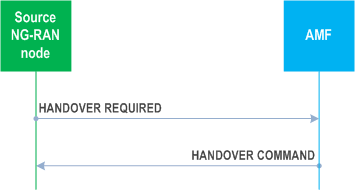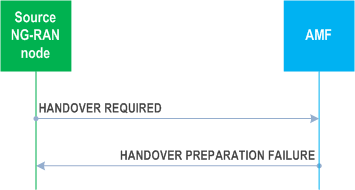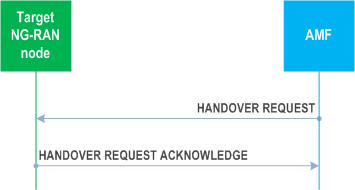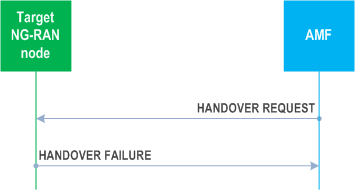Content for TS 38.413 Word version: 18.2.0
1…
4…
8…
8.2…
8.2.3…
8.3…
8.3.4…
8.4…
8.4.3…
8.5…
8.7…
8.8…
8.10…
8.12…
8.17…
9…
9.2…
9.2.2…
9.2.3…
9.2.4…
9.2.6…
9.2.7…
9.2.9…
9.2.11…
9.2.16…
9.2.17…
9.3…
9.3.1.21…
9.3.1.41…
9.3.1.61…
9.3.1.81…
9.3.1.101…
9.3.1.121…
9.3.1.141…
9.3.1.161…
9.3.1.181…
9.3.1.205…
9.3.1.222…
9.3.1.245…
9.3.2…
9.3.3…
9.3.3.21…
9.3.3.42…
9.3.4…
9.3.4.10…
9.3.5…
9.4…
9.4.4
9.4.5
9.4.6…
9.5…
10…
8.4 UE Mobility Management Procedures
8.4.1 Handover Preparation
8.4.1.1 General
8.4.1.2 Successful Operation
8.4.1.3 Unsuccessful Operation
8.4.1.4 Abnormal Conditions
8.4.2 Handover Resource Allocation
8.4.2.1 General
8.4.2.2 Successful Operation
8.4.2.3 Unsuccessful Operation
8.4.2.4 Abnormal Conditions
...
...
8.4 UE Mobility Management Procedures p. 65
8.4.1 Handover Preparation p. 65
8.4.1.1 General p. 65
The purpose of the Handover Preparation procedure is to request the preparation of resources at the target side via the 5GC. There is only one Handover Preparation procedure ongoing at the same time for a certain UE. The procedure uses UE-associated signalling.
8.4.1.2 Successful Operation p. 65

The source NG-RAN node initiates the handover preparation by sending the HANDOVER REQUIRED message to the serving AMF. When the source NG-RAN node sends the HANDOVER REQUIRED message, it shall start the timer TNGRELOCprep. The source NG-RAN node shall indicate the appropriate cause value for the handover in the Cause IE.
Upon reception of the HANDOVER REQUIRED message the AMF shall, for each PDU session indicated in the PDU Session ID IE, transparently transfer the Handover Required Transfer IE to the SMF associated with the concerned PDU session. If the UE is a mobile IAB-MT and the PDU Session ID IE contained in the HANDOVER REQUIRED message indicates no PDU session identity assigned as defined in TS 24.007, the AMF shall, if supported, consider the mobile IAB-MT has no PDU session, ignore the PDU Session Resource List IE, and behave as specified in TS 23.501.
In case of intra-system handover, the information in the Source to Target Transparent Container IE shall be encoded according to the definition of the Source NG-RAN Node to Target NG-RAN Node Transparent Container IE.
If the DL Forwarding IE is included for a given QoS flow in the PDU Session Resource Information Item IE within the Source NG-RAN Node to Target NG-RAN Node Transparent Container IE of the HANDOVER REQUIRED message and it is set to "DL forwarding proposed", it indicates that the source NG-RAN node proposes forwarding of downlink data for that QoS flow.
If the UL Forwarding IE is included for a given QoS flow in the PDU Session Resource Information Item IE within the Source NG-RAN Node to Target NG-RAN Node Transparent Container IE of the HANDOVER REQUIRED message and it is set to "UL forwarding proposed", it indicates that the source NG-RAN node proposes forwarding of uplink data for that QoS flow.
If the DRBs to QoS Flows Mapping List IE is included in the PDU Session Resource Information Item IE within the Source NG-RAN Node to Target NG-RAN Node Transparent Container IE of the HANDOVER REQUIRED message, it implicitly indicates that the source NG-RAN node proposes forwarding of downlink data for those DRBs.
If the QoS Flow Mapping Indication IE for a QoS flow is included in the Associated QoS Flow List IE within the DRBs to QoS Flows Mapping List IE within the Source NG-RAN Node to Target NG-RAN Node Transparent Container IE of the HANDOVER REQUIRED message, it indicates that the source NG-RAN node has mapped only the uplink or downlink of the QoS flow to the DRB.
The source NG-RAN node shall, for each MRB of each MBS session contained in the MBS Session Information Target to Source List IE, start data forwarding to the TNL address contained in the DL Forwarding UP TNL Information IE. If the MRB Progress Information IE is contained for an MRB in the Data Forwarding Response MRB List IE in the MBS Session Information Target to Source List IE, the source NG-RAN node may use this information to determine when to stop data forwarding.
In case of intra-system handover, if the HANDOVER COMMAND message contains the DL Forwarding UP TNL Information IE for a given DRB within the Data Forwarding Response DRB List IE in the Handover Command Transfer IE, the source NG-RAN node shall consider that the forwarding of downlink data for this DRB is accepted by the target NG-RAN node. If the HANDOVER COMMAND message contains the UL Forwarding UP TNL Information IE for a given DRB in the Data Forwarding Response DRB List IE within the Handover Command Transfer IE, it means the target NG-RAN node has requested the forwarding of uplink data for this DRB.
In case direct data forwarding is applied for inter-system handover, if the Data Forwarding Response E-RAB List IE in the Handover Command Transfer IE is included in the HANDOVER COMMAND message, the source NG-RAN node shall consider that forwarding of downlink data for this E-RAB is accepted by the target eNB.
If the HANDOVER COMMAND message contains the UL Forwarding UP TNL Information IE for a given PDU session within the Handover Command Transfer IE, the source NG-RAN node shall consider that the forwarding of uplink data of the QoS flows is accepted by the target NG-RAN node.
In case of inter-system handover to LTE, the information in the Source to Target Transparent Container IE shall be encoded according to the Source eNB to Target eNB Transparent Container IE definition as specified in TS 36.413.
If the Direct Forwarding Path Availability IE is included in the HANDOVER REQUIRED message the AMF shall handle it as specified in TS 23.502.
If the Direct Forwarding Path Availability IE is included within the Handover Required Transfer IE of the HANDOVER REQUIRED message the SMF shall handle it as specified in TS 23.502.
When the preparation, including the reservation of resources at the target side is ready, the AMF responds with the HANDOVER COMMAND message to the source NG-RAN node. In case of intra-system handover, the AMF shall include the PDU Session Resource Handover List IE in the HANDOVER COMMAND message.
Upon reception of the HANDOVER COMMAND message the source NG-RAN node shall stop the timer TNGRELOCprep and start the timer TNGRELOCoverall.
If there are any PDU sessions that could not be admitted in the target, they shall be indicated in the PDU Session Resource to Release List IE.
If the HANDOVER COMMAND message contains the QoS Flow to be Forwarded List IE and/or Data Forwarding Response DRB List IE within the Handover Command Transfer IE for a given PDU session, then the source NG-RAN node should initiate data forwarding for the QoS flows as specified in TS 38.300.
If the HANDOVER COMMAND message contains the Additional DL Forwarding UP TNL Information IE within the Handover Command Transfer IE, the source NG-RAN node should initiate data forwarding of the PDU session split in different tunnel and shall use the received UP transport layer information for the forwarding QoS flows associated to it.
If the HANDOVER COMMAND message contains the Additional UL Forwarding UP TNL Information IE within the Handover Command Transfer IE, the source NG-RAN node should initiate data forwarding of the PDU session split in different tunnels using the received UP transport layer information.
If the NAS Security Parameters from NG-RAN IE is included in the HANDOVER COMMAND message the NG-RAN node shall use it as specified in TS 33.501.
If the Target to Source Transparent Container IE has been received by the AMF from the handover target then the transparent container shall be included in the HANDOVER COMMAND message.
If the HANDOVER COMMAND message contains the QoS Flow Failed to Setup List IE within the Handover Command Transfer IE, the source NG-RAN node shall consider that the listed QoS flows are failed to be handed over.
In case of inter-system handover to LTE, the information in the Target to Source Transparent Container IE shall be encoded according to the definition of the Target eNB to Source eNB Transparent Container IE as specified in TS 36.413.
If the Index to RAT/Frequency Selection Priority IE is contained in the Source NG-RAN Node to Target NG-RAN Node Transparent Container IE, the target NG-RAN node shall store the content of the received Index to RAT/Frequency Selection Priority IE in the UE context and use it as defined in TS 23.501.
If the DAPS Request Information IE is included for a DRB in the Source NG-RAN Node to Target NG-RAN Node Transparent Container IE within the HANDOVER REQUIRED message, it indicates that the request concerns a DAPS Handover for that DRB, as described in TS 38.300.
Interactions with other NGAP procedures:
If, after a HANDOVER REQUIRED message is sent and before the Handover Preparation procedure is terminated, the source NG-RAN node receives an AMF initiated PDU Session Management procedure on the same UE-associated signalling connection, the source NG-RAN node shall either:
- Cancel the Handover Preparation procedure by executing the Handover Cancellation procedure with an appropriate cause value. After successful completion of the Handover Cancellation procedure, the source NG-RAN node shall continue the AMF initiated PDU Session Management procedure.
- Terminate the AMF initiated PDU Session Management procedure by sending the appropriate response message with an appropriate cause value, e.g. "NG intra-system handover triggered" or "NG inter-system handover triggered" to the AMF and then the source NG-RAN node shall continue with the handover procedure.
8.4.1.3 Unsuccessful Operation p. 67

If the 5GC or the target side is not able to accept any of the PDU session resources or a failure occurs during the Handover Preparation, the AMF sends the HANDOVER PREPARATION FAILURE message with an appropriate cause value to the source NG-RAN node.
If the Target to Source Failure Transparent Container IE has been received by the AMF from the handover target then the transparent container shall be included in the HANDOVER PREPARATION FAILURE message.
If the Target to Source Failure Transparent Container IE is received in the HANDOVER PREPARATION FAILURE message including the Cell CAG Information IE, the source NG-RAN node shall, if supported, store and replace the PNI-NPN information associated with the indicated cell.
Interaction with Handover Cancel procedure:
If there is no response from the AMF to the HANDOVER REQUIRED message before timer TNGRELOCprep expires in the source NG-RAN node, the source NG-RAN node should cancel the Handover Preparation procedure by initiating the Handover Cancel procedure with the appropriate value for the Cause IE. The source NG-RAN node shall ignore any HANDOVER COMMAND message or HANDOVER PREPARATION FAILURE message received after the initiation of the Handover Cancel procedure.
8.4.1.4 Abnormal Conditions p. 67
In case of inter-system handover, if the NG-RAN node receives at least one PDU Session ID included in the PDU Session Resource Handover List IE without at least one valid associated GTP tunnel address pair (in either UL or DL), then the NG-RAN node shall consider it as a logical error and act as described in subclause 10.4. A GTP tunnel address pair is considered valid if both the GTP-TEID IE and the Endpoint IP Address IE are present.
8.4.2 Handover Resource Allocation p. 68
8.4.2.1 General p. 68
The purpose of the Handover Resource Allocation procedure is to reserve resources at the target NG-RAN node for the handover of a UE. The procedure uses UE-associated signalling.
8.4.2.2 Successful Operation p. 68

The AMF initiates the procedure by sending the HANDOVER REQUEST message to the target NG-RAN node.
If the Masked IMEISV IE is contained in the HANDOVER REQUEST message the target NG-RAN node shall, if supported, use it to determine the characteristics of the UE for subsequent handling.
Upon receipt of the HANDOVER REQUEST message the target NG-RAN node shall
- attempt to execute the requested PDU session configuration and associated security;
- store the received UE Aggregate Maximum Bit Rate in the UE context, and use the received UE Aggregate Maximum Bit Rate for all Non-GBR QoS flows for the concerned UE as specified in TS 23.501;
- store the received Mobility Restriction List in the UE context;
- store the received UE Security Capabilities in the UE context;
- store the received Security Context in the UE context and take it into use as defined in TS 33.501;
- if supported, store the received UE Slice Maximum Bit Rate List in the UE context and use the received UE Slice Maximum Bit Rate List for each S-NSSAI for the concerned UE as specified in TS 23.501.
- if supported, store the received PDU Set QoS parameters in the UE context and use it as specified in TS 23.501.
- The list of QoS flows which have been successfully established in the QoS Flow Setup Response List IE.
- The Data Forwarding Accepted IE if the data forwarding for the QoS flow is accepted.
- The list of QoS flows which have failed to be established, if any, in the QoS Flow Failed to Setup List IE.
- The UP transport layer information to be used for the PDU session.
- The security result associated to the PDU session.
- The redundant UP transport layer information to be used for the redundant transmission for the PDU session.
- The PDU Set based Handling Indicator if the HANDOVER REQUEST message includes the PDU Set QoS Parameters IE.
- The ECN Marking or Congestion Information Reporting Status if the HANDOVER REQUEST message includes the ECN Marking or Congestion Information Reporting Request IE.
- determine a target for subsequent mobility action for which the target NG-RAN node provides information about the target of the mobility action towards the UE;
- select a proper SCG during dual connectivity operation;
- assign proper RNA(s) for the UE when moving the UE to RRC_INACTIVE state.
- one of the QoS flows includes a particular ARP value (TS 23.501).
- if the Trace Activation IE includes the MDT Activation IE set to "Immediate MDT and Trace", initiate the requested trace session and MDT session as described in TS 32.422;
- if the Trace Activation IE includes the MDT Activation IE set to "Immediate MDT Only", "Logged MDT only", initiate the requested MDT session as described in TS 32.422 and the target NG-RAN node shall ignore the Interfaces To Trace IE and the Trace Depth IE;
- if the Trace Activation IE includes the MDT Location Information IE within the MDT Configuration IE, store this information and take it into account in the requested MDT session;
- if the Trace Activation IE includes the Signalling Based MDT PLMN List IE within the MDT Configuration IE, the NG-RAN node may use it to propagate the MDT Configuration as described in TS 37.320.
- if the Trace Activation IE includes the Bluetooth Measurement Configuration IE within the MDT Configuration IE, take it into account for MDT Configuration as described in TS 37.320.
- if the Trace Activation IE includes the WLAN Measurement Configuration IE within the MDT Configuration IE, take it into account for MDT Configuration as described in TS 37.320.
- if the Trace Activation IE includes the Sensor Measurement Configuration IE within the MDT Configuration IE, take it into account for MDT Configuration as described in TS 37.320.
- if the Trace Activation IE includes the MDT Configuration IE and if the NG-RAN node is a gNB at least the MDT Configuration-NR IE shall be present, while if the NG-RAN node is an ng-eNB at least the MDT Configuration-EUTRA IE shall be present.
- if the Trace Activation IE includes the MN Only MDT Collection IE and the MN Only MDT Collection IE is set to "MN only", consider that the MDT Configuration-NR IE or the MDT Configuration-EUTRA IE is only applicable for the MN if the UE is configured with MR-DC.
- set the NGAP Protocol IE Support Information IE to "supported" if the target NG-RAN node has information that the functionality associated with the indicated IE is supported
- set the NGAP Protocol IE Support Information IE to "not-supported" if the target NG-RAN node has information that the functionality associated with the indicated IE is not supported
- set the NGAP Protocol IE Presence Information IE to "present" if the target NG-RAN node has received the respective NGAP Protocol IE-Id in the HANDOVER REQUEST message, and "not-present" otherwise.
If the RRC Inactive Transition Report Request IE is included in the HANDOVER REQUEST message and set to "subsequent state transition report", the NG-RAN node shall, if supported, send the RRC INACTIVE TRANSITION REPORT message to the AMF to report the RRC state of the UE when the UE enters or leaves RRC_INACTIVE state.
8.4.2.3 Unsuccessful Operation p. 75

If the target NG-RAN node does not admit any of the PDU session resources, or a failure occurs during the Handover Preparation, it shall send the HANDOVER FAILURE message to the AMF with an appropriate cause value.
If the HANDOVER REQUEST message contains within the Source NG-RAN Node to Target NG-RAN Node Transparent Container IE the NGAP IE Support Information Request List IE, the target NG-RAN node shall, if supported and the target NG-RAN node does not accept the request for handover, for each included NGAP Protocol IE-Id provided within the Target NG-RAN Node to Source NG-RAN Node Failure Transparent Container IE in the HANDOVER FAILURE message
- set the NGAP Protocol IE Support Information IE to "supported" if the target NG-RAN node has information that the functionality associated with the indicated IE is supported
- set the NGAP Protocol IE Support Information IE to "not-supported" if the target NG-RAN node has information that the functionality associated with the indicated IE is not supported
- set the NGAP Protocol IE Presence Information IE to "present" if the target NG-RAN node has received the respective NGAP Protocol IE-Id in the HANDOVER REQUEST message, and "not-present" otherwise.
8.4.2.4 Abnormal Conditions p. 76
If the supported algorithms for encryption defined in the Encryption Algorithms IE in the UE Security Capabilities IE, plus the mandated support of EEA0 and NEA0 in all UEs (TS 33.501), do not match any allowed algorithms defined in the configured list of allowed encryption algorithms in the NG-RAN node (TS 33.501), the target NG-RAN node shall reject the procedure using the HANDOVER FAILURE message.
If the supported algorithms for integrity defined in the Integrity Protection Algorithms IE in the UE Security Capabilities IE, plus the mandated support of the EIA0 and NIA0 algorithm in all UEs (TS 33.501), do not match any allowed algorithms defined in the configured list of allowed integrity protection algorithms in the NG-RAN node (TS 33.501), the target NG-RAN node shall reject the procedure using the HANDOVER FAILURE message.
If the target NG-RAN node receives a HANDOVER REQUEST message which does not contain the Mobility Restriction List IE, and the serving PLMN cannot be determined otherwise by the NG-RAN node, the target NG-RAN node shall reject the procedure using the HANDOVER FAILURE message.
If the target NG-RAN node receives a HANDOVER REQUEST message containing the Mobility Restriction List IE, and the serving PLMN indicated is not supported by the target cell, the target NG-RAN node shall reject the procedure using the HANDOVER FAILURE message.
If the target NG-RAN node receives a HANDOVER REQUEST message containing an Allowed PNI-NPN List IE in the Mobility Restriction List IE which does not allow access to the cell indicated in the Target Cell ID IE, the target NG-RAN node shall reject the procedure using the HANDOVER FAILURE message with an appropriate cause value and may include the Cell CAG Information IE corresponding to this cell and the selected PLMN.
If the target NG-RAN node receives a HANDOVER REQUEST message containing a Serving PLMN IE and Serving NID IE in the Mobility Restriction List IE which does not allow access to the cell indicated in the Target Cell ID IE, the target NG-RAN node shall reject the procedure using the HANDOVER FAILURE message with an appropriate cause value.
If the PNI-NPN Area Scope of MDT IE is included in the MDT Configuration-NR IE in the HANDOVER REQUEST message, and the Area Scope of MDT IE is set to "PNI-NPN Based MDT", the NG-RAN node shall, if supported, use the Area Scope of MDT IE to derive the MDT area scope for MDT measurement collection in PNI-NPN areas, and ignore the PNI-NPN Area Scope of MDT IE.
If the Partially Allowed NSSAI IE is received in the HANDOVER REQUEST message and the total number of S-NSSAIs included in the Allowed NSSAI and Partially Allowed NSSAI exceeds eight, the NG-RAN node shall consider the procedure as failed.
If any of the S-NSSAI which is present in the Partially Allowed NSSAI IE is also present in the Allowed NSSAI IE, the NG-RAN node shall consider the procedure as failed.